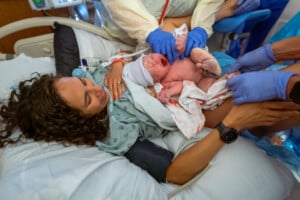Fathers being present during childbirth is a recent phenomenon, increasing in frequency since the 1970s. Much of the research into mental health conditions pre-and post-natally has focused on women. However, more men are witnessing and being a part of labor and delivery. Their responses/support directly influences their partner. So, understanding how they are impacted by birth is becoming increasingly important.1
Much of the current research into men’s mental health associated with childbirth and parenting focuses on Post-Natal Depression. However, increased attention is being paid to experiences of Post-Traumatic Stress Disorder (PTSD). Although the research is still emerging, some statistics indicate that up to 5% of men experience symptoms of PTSD following the birth of their child. This is in comparison to 7% of women who experience similar symptoms and up to 3-4% of women meet the full diagnosis of PTSD.2,3
Delivery Room PTSD in Dads
The percentage of men and women who experience delivery room PTSD symptoms is relatively similar. While it’s important to note that symptoms can be “stand-alone” and do not always equate to a formal diagnosis of any mental health condition, it would indicate that more research into men’s experiences of trauma after the birth of their child is needed.
What is PTSD?
PTSD is a mental health condition that can develop after experiencing or witnessing a traumatic event. Trauma is the emotional, psychological, and physiological residue leftover from a period of heightened stress that arises from experiences of threat, violence (physical, sexual), death, and injury. PTSD can occur from complex and ongoing experiences of trauma or a single incident of trauma. People with PTSD experience a wide range of symptoms, but they can include:4
- Nightmares, unwanted or intrusive thoughts about the incident, flashbacks
- Feeling emotional and distressed after being reminded of the event
- Experiencing a physical response after being reminded of the vent, things like heart racing, sweating, shallow and fast breathing, shaking, etc
- Avoiding things that might trigger or remind them of the incident
- Changes to thoughts and mood, including; trouble remembering parts of the traumatic event, having negative thoughts about oneself and the world, having a low or negative mood, lack of interest in things they would usually enjoy, feeling isolated
- Increased reactivity and arousal (feeling heightened), including aggression, irritability, risky behaviors, easily startled, hypervigilant, trouble sleeping, or difficulty concentrating
(Please note that this is not an exhaustive list. Diagnosing PTSD can be complicated and should only be done by a trained professional who will assess symptoms against the Diagnostic and Statistical Manual of Mental Disorders 5 (DSM-5), a diagnostic tool.)
“But you’re not the one who gave birth!”
Unfortunately, this may be the response to fathers who express feeling distressed and overwhelmed after witnessing the traumatic birth of their child. Although they didn’t give birth, they have the right to be impacted by the event. Remember, the diagnosis of PTSD, or experiencing symptoms of PTSD, can arise from witnessing a traumatic event.
Even during a “routine” birth, many men report that they felt unsure about their role in labor or helpless at their inability to support their partner who was experiencing pain.5 However, in traumatic births, this lack of control or ability to “help” can be magnified, with some men reporting feeling “alienated” or a spectator, isolated or excluded by the health care staff who were prioritizing the health of partner/child and trying to push down or hide their distress.6
As more men enter the labor rooms, they become more exposed to the rollercoaster of childbirth. Even for routine births, it can be distressing to feel alone, unsure of how to help their partner in pain, or feeling like their own worries and stress aren’t important because they aren’t the one birthing. Although the research is still relatively new, it indicates that a traumatic birth can affect men, resulting in delivery room PTSD, just as much as their partners. As one of the primary supports for the mother post-delivery. It is integral that men’s mental health and coping are taken care of (as well as mothers). This will be for their own benefit and the influence this can have on their relationships and the recovery/well-being of their partner.

























